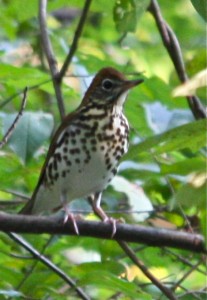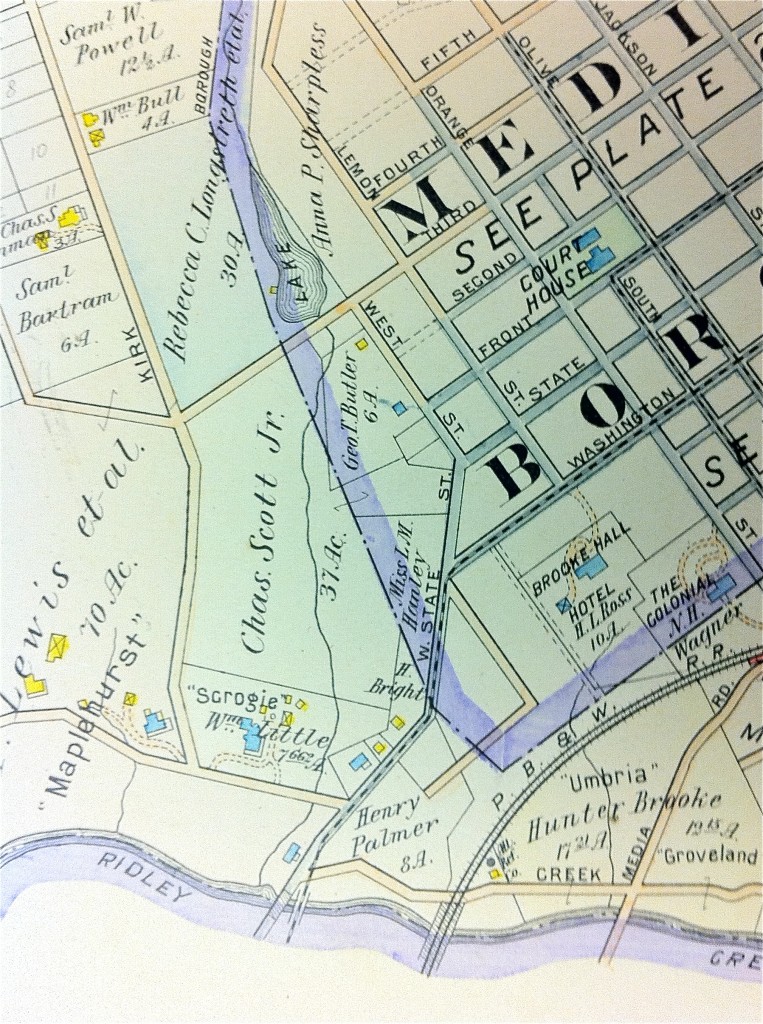Pre-park history: Scroggie Valley!
Before Glen Providence Park was established, its valley was called Scroggie! [1] It was even the setting for an 18th century Ghost Story!
From a description of Media in 1900: “Turn to the west, and you shall see a landscape not devoid of wildness. Scroggie valley… with its lake and its rill; [2] the wide vale of Ridley Creek…; Mineral Hill, rugged and scarred; the heights of Lima and the stately dome of Elwyn. And when the sun sinks of a summer evening behind those western hills, and the hues of that landscape shift and change; or when of an afternoon, a thunder storm comes slowly down the valley; then does one at last perceive the full charm of this little bit of the world which is at his own door.” [3] [bold added]
In 1889, T. Chalkley Palmer wrote about “Scroggie”, [4] fondly recounting his exploration of Scroggie Valley since early childhood. “As for the valley and its hills as they now are, I have known all their nooks since the beauty, the quietness, and the nameless charm of Scroggie drew my steps through the opening, and by degrees toward the far, blue, woody ending thereof more than twenty years ago.” [5]
T.C. Palmer admired Scroggie’s plants: trailing arbutus, laurel, blackberries, purple lady’s slipper, “jewel-weeds”, oaks and chestnut trees; [6] its birds: chewink, oven-bird and “wood-robin”; [7] and its fish: redfins, minnows, sunfish and roach. In Scroggie Valley, a young T.C. Palmer learned to distinguish frog and toad eggs. His tales of wildlife encounters include lizards, black snakes, woodchuck, snappers, grasshoppers, crickets, and a story about catching a watersnake named Joe, who refused to eat in captivity: “A council was held, and as a result we carried him back to Scroggie and liberated him.”
Who was T. Chalkley Palmer? He grew up at a mill house along Ridley Creek where the Aqua plant is located- at the mouth of Scroggie Valley. He went on to become the president both of the Delaware County Institute of Science, and of the Academy of Natural Sciences in Philadelphia!
It is fortunate to have this detailed 1889 description of Scroggie Valley as a reference for today’s Glen Providence Park!
Scroggie House:
We don’t know which was named first, the house or the valley. A house at Kirk Lane & Ridley Creek Road, near the mouth of Broomall’s Run, was called Scroggie as late as 1952. It was said to be named after a shingle mill that was once in Scroggie Valley where the park is now located. [8]
End Notes:
[1] Scroggie is a Scottish word which means “covered with underwood, bushy.”
[2] The lake is Broomall’s Lake, and a rill is a small brook. The brook is now called Broomall’s Run.
[3] Quote from the “Semi-centennial of the borough of Media, Penna, May 19, 1900”
[4] T. Chalkley Palmer’s 13 page essay “Scroggie” was published over three issues of a Philadelphia monthly The Student, the 1889-1890 issues being compiled in one volume:
– “Scroggie: Where and What It Is,” December 1889, pages 91-94
– “Scroggie: Early Memories,” January 1890, pages 122-126
– “Scroggie As It Is,” February 1890, pages 169-172
[5] That the valley of Broomall’s Run is Scroggie Valley is confirmed in T. Chalkley Palmer’s December 1889 essay, stating “Scroggie stream meets Elwyn stream face to face at Ridley Brook.” You can confirm this on Google maps!
[6] Oak remains a predominant tree in the valley, but the majestic American Chestnut tree was virtually eliminated in North America by a blight in the early 1900’s. Decades of research have been done in an effort to bring them back, including at the Chestnut Nursery at Tyler Arboretum in Media.
[7] Chewink is a towhee of eastern North America. “Wood-robin” is a common name for the Wood Thrush: its flute-like song can still be heard in Glen Providence Park!
[8] We found this 1909 map in the Media Historic Archives that shows the Scroggie house (spelled Scrogie on the map).
The November 13, 1948 Chester Times obituary of Louis Little indicates that his family estate Scroggie “was named for an old shingle mill that was located in the valley where Glen Providence Park is now situated”.
We will update these notes as we gather more information!
Researched by Stephanie Gaboriault











Really enjoyed your website. I am a daily dog walker at the Park and have lived nearby my entire 54 years. As a child we played Army,hide and seek and explored the park all year long.We hid from the Park Guard and scared each other with tales of “The Sheep Man” who walked the park at night with a severed sheep head! Reading about “The Iron Spring” brought to mind a spring that we always drank from each time we went to the Park. At the bottom of the zig-zag trail coming from the Kirk Lane entrance…if you made a left heading toward the waterfall there was an iron pipe sticking out of the hill with ice cold spring water flowing out.A steel grate served as a drain and I often wonder what became of it. Also,I never visit without looking at the plaque that still remains at the bottom of a long gone waterfall dedicated to Elinor Reed Butler.The park was and still is very special place to me and the vandalism and neglect that it has suffered in the last 25 years or so is sad. Appreciate your efforts on the park’s behalf and I hope that the present generation does not vandalize and destroy what you are trying to accomplish. I have a half century of Glen Providence memories in my heart and head…e-mail me if you wish.Thank You….Dave Black
Hi Dave, How fun to hear of your memories of the Park Guard, hide and seek, the Iron Spring, and the Eleanor Butler Waterfall! We found what we think is the location of the drinking spring, but it is now difficult to access. Actually, its location is right along the edge of what may be filled in for the proposed dam replacement. I would love to see the park as it was in its early decades, but we are enjoying our work to restore it now. Thank you for your kind words, and for appreciating the park!
You’re welcome…Also I once heard Frank Lees (A true Media Treasure) say that Scroggie meant “Wild Duck”…thought of that when I saw it defined as meaning underbrush.I will check in from time to time with more memories.Thanks…Dave,Carly,Phil and Taz(My three dogs who also love The Park!)